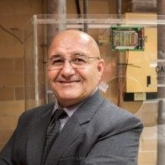Photocatalysts in Wastewater Treatment
A special issue of Catalysts (ISSN 2073-4344). This special issue belongs to the section "Environmental Catalysis".
Deadline for manuscript submissions: closed (31 May 2021) | Viewed by 2760
Special Issue Editors
Interests: advanced treatment of water and wastewater; waste minimization and water reuse; integration of advanced oxidation technologies and biological processes for industrial wastewater treatment; water, soil, and air quality; energy and resource recovery
Special Issues, Collections and Topics in MDPI journals
Interests: water, soil, and air quality; environmental modelling; transport and fate of pollutants; water and wastewater treatment technologies: modelling and simulation.
Special Issues, Collections and Topics in MDPI journals
Interests: heterogeneous catalysis; thin films and nanotechnology; chemical reaction engineering; adsorption; industrial wastewater treatment by solar photocatalysis; novel material synthesis for advanced oxidation processes applications
Special Issues, Collections and Topics in MDPI journals
Interests: photochemical reaction engineering, including photocatalysis, UV/hydrogen peroxide, fenton/photo-fenton, etc.; integration of advanced oxidation technologies and biological processes for wastewater treatment; effects of climate change on the quality and quantity of groundwater
Special Issues, Collections and Topics in MDPI journals
Special Issue Information
Dear Colleagues,
Advanced wastewater treatment technologies, specifically in photocatalysis, are becoming attractive alternative and complementary treatments to traditional treatment methods. Among the diverse advanced oxidation processes (AOPs), photocatalysis is used to improve wastewater biodegradability, eliminate recalcitrant organics, and disinfect waterborne and airborne pathogens. This Special Issue of Catalysts aims to cover the state-of-the-art of photocatalysis in wastewater treatment, recent progress and trends in the field of photocatalyst development, nanotechnology applications, the degradation of emerging contaminants, the development of novel catalytic materials, and the combination of photocatalysis with other wastewater treatment technologies, among other relevant topics. Authors with expertise in photocatalysis for wastewater treatment are invited to submit their original research and review articles to Catalysts.
Dr. Ciro Bustillo-Lecompte
Dr. Edgar Edgar Quiñones-Bolaños
Dr. Jose Colina-Márquez
Prof. Dr. Mehrab Mehrvar
Guest Editors
Manuscript Submission Information
Manuscripts should be submitted online at www.mdpi.com by registering and logging in to this website. Once you are registered, click here to go to the submission form. Manuscripts can be submitted until the deadline. All submissions that pass pre-check are peer-reviewed. Accepted papers will be published continuously in the journal (as soon as accepted) and will be listed together on the special issue website. Research articles, review articles as well as short communications are invited. For planned papers, a title and short abstract (about 100 words) can be sent to the Editorial Office for announcement on this website.
Submitted manuscripts should not have been published previously, nor be under consideration for publication elsewhere (except conference proceedings papers). All manuscripts are thoroughly refereed through a single-blind peer-review process. A guide for authors and other relevant information for submission of manuscripts is available on the Instructions for Authors page. Catalysts is an international peer-reviewed open access monthly journal published by MDPI.
Please visit the Instructions for Authors page before submitting a manuscript. The Article Processing Charge (APC) for publication in this open access journal is 2700 CHF (Swiss Francs). Submitted papers should be well formatted and use good English. Authors may use MDPI's English editing service prior to publication or during author revisions.
Keywords
- photocatalysis
- advanced oxidation technologies
- wastewater treatment
- hybrid processes
- process intensification
- photocatalytic reaction engineering
- photocatalyst development
- novel doping methods
- photoreactor design
- photocatalytic efficiency








